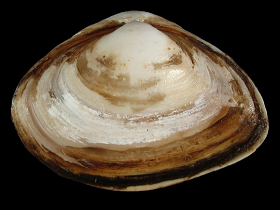Asian clam

[Image: YHshells; Hao Yang]
Status in New Zealand
Not in New Zealand
Legal Status in New Zealand
Unwanted organism
Description
The Asian clam is native to the northwest Pacific ocean, occurring in eastern Russia, Japan and China. It has only been found outside its native range in the San Francisco estuary, USA. It is a habitat generalist that can tolerate a broad range of salinities and survive in environments with low oxygen. The Asian clam occurs in sand, mud and clay sediments normally within shallow subtidal environments and intertidal mudflats. The clam is thought to have been introduced to San Francisco estuary as larvae in vessel ballast water. Some populations in San Francisco estuary appear to spawn year round and newly settled individuals are able to reproduce themselves within a few months. Individual clams can produce up to 220,000 eggs at a time.
Why is it a problem?
The Asian clam can occur in very high densities; over 25,000 per square metre. In some parts of San Francisco Bay estuary it makes up most of the biomass in the sediments. The Asian clam feeds on plankton and other organic material that is suspended in the water. At high densities, it can reduce the concentration of plankton in the water and its availability to other organisms. In San Francisco the clam is thought to have indirectly contributed to a dramatic decline in the catch rate of some fish species. It also filters toxins present in the water column which may lead to increased exposure of toxins to animals that consume them.
Hear about the impacts of the Asian clam and other invaders in San Francisco Bay, USA. [KQED QUEST Productions]
What do they look like?
Key features
The shell of the Asian clam can be yellow, tan or dirty white with brown staining. It measures up to 3 cm in length. One side of the shell is larger than the other, resulting in a distinctive "overbite". Old shells may have wrinkled edges
Download an identification guide
- Asian clam i.d. guide [PDF, 1 MB]